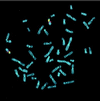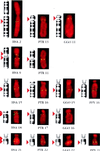Fluorescence in situ hybridization analysis of keratinocyte growth factor gene amplification and dispersion in evolution of great apes and humans
- PMID: 9326632
- PMCID: PMC23506
- DOI: 10.1073/pnas.94.21.11461
Fluorescence in situ hybridization analysis of keratinocyte growth factor gene amplification and dispersion in evolution of great apes and humans
Abstract
Keratinocyte growth factor (KGF) is a member of the fibroblast growth factor family. Portions of the gene encoding KGF were amplified during primate evolution and are present in multiple nonprocessed copies in the human genome. Nucleotide analysis of a representative sampling of these KGF-like sequences indicated that they were at least 95% identical to corresponding regions of the KGF gene. To localize these sequences to specific chromosomal sites in human and higher primates, we used fluorescence in situ hybridization. In human, using a cosmid probe encoding KGF exon 1, we assigned the location of the KGF gene to chromosome 15q15-21.1. In addition, copies of KGF-like sequences hybridizing only with a cosmid probe encoding exons 2 and 3 were localized to dispersed sites on chromosome 2q21, 9p11, 9q12-13, 18p11, 18q11, 21q11, and 21q21.1. The distribution of KGF-like sequences suggests a role for alphoid DNA in their amplification and dispersion. In chimpanzee, KGF-like sequences were observed at five chromosomal sites, which were each homologous to sites in human, while in gorilla, a subset of four of these homologous sites was identified; in orangutan two sites were identified, while gibbon exhibited only a single site. The chromosomal localization of KGF sequences in human and great ape genomes indicates that amplification and dispersion occurred in multiple discrete steps, with initial KGF gene duplication and dispersion taking place in gibbon and involving loci corresponding to human chromosomes 15 and 21. These findings support the concept of a closer evolutionary relationship of human and chimpanzee and a possible selective pressure for such dispersion during the evolution of higher primates.
Figures



References
Publication types
MeSH terms
Substances
LinkOut - more resources
Full Text Sources
Molecular Biology Databases
Research Materials
Miscellaneous

